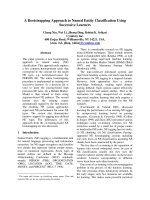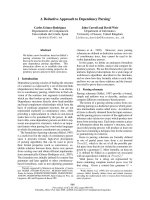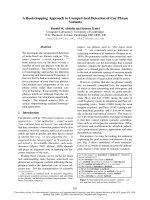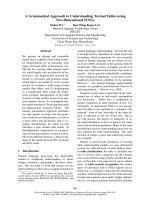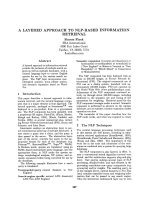Báo cáo khoa học: "A Two-Stage Approach to Retrieving Answers for How-To Questions" pot
Bạn đang xem bản rút gọn của tài liệu. Xem và tải ngay bản đầy đủ của tài liệu tại đây (128.47 KB, 8 trang )
A Two-Stage Approach to Retrieving Answers for How-To
Questions
Ling Yin
CMIS, University of Brighton,
Brighton, BN2 4GJ, United Kingdom
Abstract
This paper addresses the problem of
automatically retrieving answers for
how-to questions, focusing on those that
inquire about the procedure for
achieving a specific goal. For such
questions, typical information retrieval
methods, based on key word matching,
are better suited to detecting the content
of the goal (e.g., ‘installing a Windows
XP server’) than the general nature of the
desired information (i.e., procedural, a
series of steps for achieving this goal).
We suggest dividing the process of
retrieving answers for such questions
into two stages, with each stage focusing
on modeling one aspect of a how-to
question. We compare the two-stage
approach with two alternative
approaches: a baseline approach that
only uses the content of the goal to
retrieve relevant documents and another
approach that explores the potential of
automatic query expansion. The result of
the experiment shows that the two-stage
approach significantly outperforms the
baseline but achieves similar result with
the systems using automatic query
expansion techniques. We analyze the
reason and also present some future work.
1 Introduction
How-To questions constitute a large proportion
of questions on the Web. Many how-to questions
inquire about the procedure for achieving a
specific goal. For such questions, typical
information retrieval (IR) methods, based on key
word matching, are better suited to detecting the
content of the goal (e.g., installing a Windows
XP server) than the general nature of the desired
information (i.e., procedural, a series of steps for
achieving this goal). The reasons are given as
below.
First, documents that describe a procedure
often do not contain the word ‘procedure’ itself,
but we are able to abstract the concept
‘procedure’ from cues such as ‘first’, ‘next’ and
‘then’, all of which indicate sequential
relationships between actions. Secondly, We
expect that the word ‘procedure’ or the phrase
‘how to’ will occur in a much broader context
than the words in the goal. In other words, a
document that contains the words in the goal is
more likely to be relevant than a document that
contains the word ‘procedure’ or the phrase ‘how
to’. Without noticing this difference, treating the
two parts equally in the retrieving process will
get many noisy documents.
Many information requests seem to show such
a structure, with one part identifying a specific
topic and another part constraining the kind of
information required about this topic (Yin and
Power, 2005). The second part is often omitted
when selecting retrieval terms from the request to
construct an effective query for an IR system,
such as in Picard (1999).
The first point given above suggests that using
cues such as ‘first’ and ‘next’ to expand the
initial query may help in retrieving more relevant
documents. Expansion terms can be generated
automatically by query expansion techniques.
The typical process is: (1) use the initial query to
retrieve documents (referred to as the first round
of retrieval); (2) consider a few top ranked
documents as relevant and the rest irrelevant; (3)
compare the relevant set with the irrelevant set to
extract a list of most distinctive terms; (4) use the
extracted terms to retrieve documents (referred to
as the second round of retrieval).
However, query expansion may not constitute
a good solution, because its effectiveness largely
63
depends on the quality of the few top ranked
documents retrieved in the first round when the
aforementioned two problems are not yet
tackled.
Our solution is to divide the process of
retrieving answers for such questions into two
stages: (1) use typical IR approaches for
retrieving documents that are relevant to the
specific goal; (2) use a text categorization
approach to re-rank the retrieved documents
according to the proportion of procedural text
they contain. By ‘procedural text’ we refer to
ordered lists of steps, which are very common in
some instructional genres such as online manuals.
In this report, we will briefly introduce the
text categorization approach (details are
presented in (Yin and Power, 2006) ) and will
explain in more concrete terms how it is
integrated into the two-stage architecture
proposed above. We will compare the
performance of our two-stage architecture with a
baseline system that uses only the content of the
goal to retrieve relevant documents (equivalent
to the first stage in the two-stage architecture).
We will also compare the two-stage approach
with systems that applies automatic query
expansion techniques.
This paper is organized as follows. Section 2
introduces some relevant work in IR and
question answering (QA). Section 3 talks about
the text categorization approach for ranking
procedural documents, covering issues such as
the features used, the training corpus, the design
of a classification model as well as some
experiments for evaluation. Section 4 talks about
integrating the text categorizer into the two-stage
architecture and presents some experiments on
retrieving relevant documents for how-to
questions. Section 5 provides a short summary
and presents some future work.
2 Related Work
The idea of applying text categorization
technology to help information retrieval is not
new. In particular, text categorization techniques
are widely adopted to filter a document source
according to specific information needs. For
example, Stricker et al. (2000) experiment on
several news resources to find news addressing
specific topics. They present a method for
automatically generating “discriminant terms”
(Stricker et al., 2000) for each topic that are then
used as features to train a neural network
classifier. Compared to these approaches, the
novelty of our study lies in the idea that an
information request consists of two different
parts that should be retrieved in different ways
and the whole retrieval process should adopt a
two-stage architecture.
A research area that is closely related to IR is
question answering (QA), the differences being
a) the input of a QA system is a question rather
than a few key words; b) a QA system aims to
extract answers to a question rather than
retrieving relevant documents only. Most QA
systems do adopt a two-stage architecture (if not
consider the initial question analysis stage), i.e.,
perform IR with a few content words extracted
from the query to locate documents likely to
contain an answer and then use information
extraction (IE) to find the text snippets that
match the question type (Hovy et al., 2001;
Elworthy, 2000). However, most question
answering systems target factoid questions – the
research of non-factoid questions started only a
few years ago but limited to several kinds, such
as definitional questions (Xu et al., 2003) and
questions asking for biographies (Tsur et al.,
2004).
Only a few studies have addressed procedural
questions. Murdok and Croft (2002) distinguish
between “task-oriented questions” (i.e., ask about
a process) and “fact-oriented questions” (i.e., ask
about a fact) and present a method to
automatically classify questions into these two
categories. Following this work, Kelly et al.
(2002) explore the difference between documents
that contain relevant information to the two
different types of questions. They conclude,
“lists and FAQs occur in more documents judged
relevant to task-oriented questions than those
judged relevant to fact-oriented questions” (Kelly
et al., 2002: 645) and suggest, “retrieval
techniques specific to each type of question
should be considered” (Kelly et al., 2002: 647).
Schwitter et al. (2004) present a method to
extract answers from technical documentations
for How-questions. To identify answers, they
match the logical form of a sentence against that
of the question and also explore the
typographical conventions in technical domains.
The work that most resembles ours is Takechi et
al. (2003), which uses word n-grams to classify
(as procedural or non-procedural) list passages
extracted using HTML tags. Our approach,
however, applies to whole documents, the aim
being to measure the degree of procedurality —
i.e., the proportion of procedural text they
contain.
64
3 Ranking Procedural Texts
Three essential elements of a text categorization
approach are the features used to represent the
document, the training corpus and the machine
learning method, which will be described in
section 3.1, 3.2 and 3.3 respectively. Section 3.4
presents experiments on applying the learned
model to rank documents in a small test set.
3.1 Feature Selection and Document
Representation
Linguistic Features and Cue Phrases
We targeted six procedural elements: actions,
times, sequence, conditionals, preconditions, and
purposes. These elements can be recognized
using linguistic features or cue phrases. For
example, an action is often conveyed by an
imperative; a precondition can be expressed by
the cue phrase ‘only if’. We used all the
syntactic and morphological tags defined in
Connexor’s syntax analyzer
1
. There are some
redundant tags in this set. For example, both the
syntactic tag ‘@INFMARK>’ and the
morphological tag ‘INFMARK>’ refer to the
infinitive marker ‘to’ and therefore always occur
together at the same time. We calculated the
Pearson’s product-moment correlation
coefficient (r) (Weisstein, 1999) between any
two tags based on their occurrences in sentences
of the whole training set. We removed one in
each pair of strongly correlated tags and finally
got 34 syntactic tags and 34 morphological tags.
We also handcrafted a list of relevant cue
phrases (44), which were extracted from
documents by using the Flex tool
2
for pattern
matching. Some sample cue phrases and the
matching patterns are shown in table 1.
Procedural
Element
Cue Phrase Pattern
Precondition ‘only if’ [Oo]nly[[:space:]]if[[:space:]]
Purpose ‘so that’ [sS]o[[:space:]]that[[:space:]]
Condition ‘as long as’ ([Aa]s) [[:space:]]long[[:space:]]as[[:space:]]
Sequence ‘first’ [fF]irst [[:space:][:punct:]]
Time ‘now’ [nN]ow[[:space:][:punct:]]
Table 1. Sample cue phrases and matching
patterns.
Modeling Inter-Sentential Feature Co-
occurrence
Some cue phrases are ambiguous and therefore
cannot reliably suggest a procedural element.
For example, the cue phrase ‘first’ can be used to
1
Refer to
2
Refer to />represent a ranking order or a spatial relationship
as well as a sequential order. However, it is more
likely to represent a sequential order between
actions if there is also an imperative in the same
sentence. Indeed, sentences that contain both an
ordinal number and an imperative are very
frequent in procedural texts. We compared
between the procedural training set and the non-
procedural training set to extract distinctive
feature co-occurrence patterns, each of which has
only 2 features. The formulae used to rank
patterns with regard to their distinctiveness can
be found in (Yin and Power, 2006).
Document Representation
Each document was represented as a vector
{ }
Njjj
j
xxxd , ,,
21
= , where
ij
x represents the
number of sentences in the document that
contains a particular feature normalized by the
document length. We compare the effectiveness
of using individual features (
ij
x refers to either a
single linguistic feature or a cue phrases) and of
using feature co-occurrence patterns (
ij
x refers to
a feature co-occurrence pattern).
3.2 Corpus Preparation
Pagewise
3
provides a list of subject-matter
domains, ranging from household issues to arts
and entertainment. We downloaded 1536
documents from this website (referred to
hereafter as the Pagewise collection). We then
used some simple heuristics to select documents
from this set to build the initial training corpus.
Specifically, to build the procedural set we chose
documents with titles containing key phrases
‘how to’ and ‘how can I’ (209 web documents);
to build the non-procedural set, we chose
documents which did not include these phrases
in their titles, and which also had no phrases like
‘procedure’ and ‘recipe’ within the body of the
text (208 web documents).
Samples drawn randomly from the procedural
set (25) and non-procedural set (28) were
submitted to two human judges, who assigned
procedurality scores from 1 (meaning no
procedural text at all) to 5 (meaning over 90%
procedural text). The Kendall tau-b agreement
(Kendall, 1979) between the two rankings was
0.821. Overall, the average scores for the
procedural and non-procedural samples were
3.15 and 1.38. We used these 53 sample
documents as part of the test set and the
3
Refer to
65
remaining documents as the initial training set
(184 procedural and 180 non-procedural).
This initial training corpus is far from ideal:
first, it is small in size; a more serious problem is
that many positive training examples do not
contain a major proportion of procedural text. In
our experiments, we used this initial training set
to bootstrap a larger training set.
3.3 Learning Method
Although shown to be not so effective in some
previous studies (Yang, 1999; Yang and Liu,
1999), Naive Bayes classifier is one of the most
commonly-used classifiers for text
categorization. Here we introduce a model
adapted from the Naive Bayes classifier from the
weka-3-4 package (Witten and Frank, 2000).
The Naive Bayes classifier scores a document
j
d according to whether it is a typical member
of its set — i.e., the probability of randomly
picking up a document like it from the
procedural class (
(
)
proceduralCdp
j
=| ). This
probability is estimated from the training corpus.
As mentioned before, the average procedural
score of the procedural training set is low.
Therefore, there is obviously a danger that a true
procedural document will be ranked lower than a
document that contains less procedural texts
when using this training set to train a Naive
Bayes classifier. Although our procedural
training set is not representative of the
procedural class, by comparing it with the non-
procedural training set, we are able to tell the
difference between procedural documents and
non-procedural documents. We adapted the
Naive Bayes classifier to focus on modeling the
difference between the two classes. For example,
if the procedural training set has a higher
average value on feature Xi than the non-
procedural training set, we inferred that a
document with a higher feature value on Xi
should be scored higher. To reflect this rule, we
scored a document
j
d by the probability of
picking a document with a lower feature value
from the procedural class (i.e.,
)|( proceduralCxXp
iji
=< ). Again this
probability is estimated from the training set.
The new model will be referred to hereafter as
the Adapted Naive Bayes classifier. The details
of this new model can be found in (Yin and
Power, 2006).
3.4 Experiments on Ranking Procedural
Texts
There are two sources from which we compiled
the training and testing corpora: the Pagewise
collection and the SPIRIT collection. The
SPIRIT collection contains a terabyte of HTML
that are crawled from the web starting from an
initial seed set of a few thousands universities
and other educational organizations (Clarke et
al., 1998).
Our test set contained 103 documents,
including the 53 documents that were sampled
previously and then separated from the initial
training corpus, another 30 documents randomly
chosen from the Pagewise collection and 20
documents chosen from the SPIRIT collection.
We asked two human subjects to score the
procedurality for these documents, following the
same instruction described in section 3.2. The
correlation coefficient (Kendall tau-b) between
the two rankings was 0.725, which is the upper
bound of the performance of the classifiers.
We first used the initial training corpus to
bootstrap a larger training set (378 procedural
documents and 608 non-procedural documents),
which was then used to select distinctive feature
co-occurrence patterns and to train different
classifiers. We compared the Adapted Naive
Bayes classifier with the Naive Bayes classifier
and three other classifiers, including Maximum
Entropy (ME)
4
, Alternating Decision Tree
(ADTree) (Freund and Mason, 1999) and Linear
Regression (Witten and Frank, 2000).
6XE
6XE
Figure 1. Ranking results using individual
features: 1 refers to Adapted Naive Bayes, 2
refers to Naive Bayes, 3 refers to ME, 4 refers to
ADTree and 5 refers to Linear Regression.
Ranking Method Agreement
with Subject 1
Agreement
with Subject 2
Average
Adapted Naive Bayes
0.270841
0.367515
0.319178
Naive Bayes
0.381921 0.464577 0.423249
ME
0.446283 0.510926 0.478605
4
Refer to
66
ADTree
0.371988 0.463966 0.417977
Linear Regression
0.497395 0.551597 0.524496
Table 2. Ranking results using individual
features.
6XE
6XE
Figure 2. Ranking results using feature co-
occurrence patterns: 1 refers to Adapted Naive
Bayes, 2 refers to Naive Bayes, 3 refers to ME, 4
refers to ADTree and 5 refers to Linear
Regression.
Ranking Method Agreement
with Subject 1
Agreement
with Subject 2
Average
Adapted Naive Bayes
0.420423 0.513336 0.466880
Naive Bayes
0.420866
0.475514 0.44819
ME
0.414184 0.455482 0.434833
ADTree
0.358095 0.422987 0.390541
Linear Regression
0.190609 0.279472 0.235041
Table 3. Ranking results using feature co-
occurrence patterns.
Figure 1 and table 2 show the Kendall tau-b
coefficient between human subjects’ ranking
results and the trained classifiers’ ranking results
of the test set when using individual features
(112); Figure 2 and table 3 show the Kendall
tau-b coefficient when using feature co-
occurrence patterns (813).
As we can see from the above figures, when
using individual features, Linear Regression
achieved the best result, Adapted Naive Bayes
performed the worst, Naive Bayes, ME and
ADTree were in the middle; however, when
using feature co-occurrence patterns, the order
almost reversed, i.e., Adapted Naive Bayes
performed the best and Linear Regression the
worst. Detailed analysis of the result is beyond
the scope of this paper. The best model gained
by using feature co-ocurrence patterns (i.e.,
Adapted Naive Bayes classifier) and by using
individual features (i.e., Linear Regression
classification model) will be used for further
experiments on the two-stage architecture.
4 Retrieving Relevant Documents for
How-To Questions
In this section we will describe the experiments
on retrieving relevant documents for how-to
questions by applying different approaches
mentioned in the introduction section.
4.1 Experiment Setup
We randomly chose 60 how-to questions from
the query logs of the FA Q finder system (Burke
et al., 1997). Three judges went through these
questions and agreed on 10 procedural
questions
5
.
We searched Google and downloaded 40 top
ranked documents for each question, which were
then mixed with 1000 web documents from the
SPIRIT collection to compile a test set. The two-
stage architecture is as shown in figure 3. In the
first stage, we sent only the content of the goal to
a state-of-the-art IR model to retrieve 30
documents from the test set, which were
reranked in the second stage according to the
degree of procedurality by a trained document
classifier.
7HVWVHW ,5PRGHO
WRS
UDQNHG
ZHEGRFV
'RFXPHQW
FODVVLILHU
UHUDQNHG
ZHEGRFV
7KHFRQWHQW
RIWKHJRDO
Figure 3. A two-stage architecture.
We also tried to test how well query expansion
could help in retrieving procedural documents,
following a process as shown in figure 4. First,
key words in the content of goal were used to
query an IR model to retrieve an initial set of
relevant documents, those of which that do not
contain the phrase ‘how to’ were then removed.
The remaining top ten documents were used to
generate 40 searching terms, which were applied
in the second round to retrieve documents.
Finally the 30 top ranked documents were
returned as relevant documents.
5
We distinguish questions asking for a series of steps
(i.e., procedural questions) from those of which the
answer could be a list of useful hints, e.g., ‘how to
make money’.
Stage One
Sta
g
e Two
67
,5PRGHO 7HVWVHW
'RFXPHQW
UDQNLQJOLVW
,5PRGHO
WRS
UDQNHG
ZHEGRFV
([WUDFWWHUPVIRU
TXHU\H[SDQVLRQ
$QH[SDQGHG
VHWRITXHU\
WHUPV
7KHFRQWHQW
RIWKHJRDO
5HPRYHGRFXPHQWV
FRQWDLQLQJQR
ಪKRZWRಫ
WRS
UDQNHGZHE
GRFV
Figure 4. An alternative architecture using query
expansion.
4.2 IR Model
For the above-mentioned IR model, we used the
BM25 and PL2 algorithms from the Terrier IR
platform
6
.
The BM25 algorithm is one variety of the
probabilistic schema presented in (Robertson et
al. 1993). It has gained much success in TREC
competitions and has been adopted by many
other TREC participants.
The PL2 algorithm, as most other IR models
implemented in the Terrier IR platform, is based
on the Divergence From Randomness (DFR)
framework. Amati and Rijsbergen (2004)
provide a detailed explanation of this framework
and a set of term-weighting formulae derived by
applying different models of randomness and
different ways to normalize the weight of a term
according to the document length and according
to a notion called information gain. They test
these different formulae in the experiments on
retrieving relevant documents for various sets of
TREC topics and show that they achieve
comparable result with the BM25 algorithm.
We also used the Bo1 algorithm from the
same package to select terms for query
expansion. Refer to (Plachouras et al., 2004) for
details about this algorithm.
4.3 Result
We tested eight systems, which could be
organized into two sets. The first set uses BM25
algorithm as the basic IR model and the second
set uses PL2 as the basic IR model. Each set
includes four systems: a baseline system that
returns the result of the first stage in the two-
stage architecture, one system that uses query
expansion technique following the architecture
in figure 4 and two systems that apply the two-
6
stage architecture (one uses the Adapted Naive
Bayes classifier and another one uses the Linear
Regression classification model).
The mean average precision (MAP)
7
of
different retrieval systems is shown in table 4
and figure 5.
0
0. 1
0. 2
0. 3
0. 4
0. 5
0. 6
1 2
Basel i ne
Query Expansi on
Adapt ed Nai ve Bayes
Li near Regr essi on
Figure 5. MAPs of different systems: 1 refers to
using BM25 as the IR model, 2 refers to using
PL2 as the IR model.
Model MAP
BM25 (Baseline) 0.33692
Set1 BM25 + Query Expansion 0.50162
BM25 + Adapted Naive Bayes 0.45605
BM25 + Linear Regression 0.41597
PL2 (Baseline) 0.33265
Set2 PL2 + Query Expansion 0.45821
PL2 + Adapted Naive Bayes 0.44263
PL2 + Linear Regression 0.40218
Table 4. Results of different systems.
We can see that in both sets: (1) systems that
adopts the two-stage architecture performed
better than the baseline system but worse than
the system that applies query expansion
technique; (2) the system that uses Adapted
Naive Bayes classifier in the second stage gained
better result than the one that uses Linear
Regression classification model. We performed a
pairwise t-test to test the significance of the
difference between the results of the two systems
with an integrated Adapted Naive Bayes
classifier and of the two baseline systems. Each
data set contained 20 figures, with each figure
representing the average precision of the
retrieving result for one question. The difference
is significant (p=0.02). We also performed a
pairwise t-test to test the significance of the
difference between the two systems with an
integrated Adapted Naive Bayes classifier and of
7
The average precision of a single question is the
mean of the precision scores after each relevant
document is retrieved. The mean average precision is
the mean of the average precisions of a collection of
questions.
Round One
Round Two
68
the two systems using query expansion
techniques. The difference is not significant
(p=0.66).
4.4 Discussion
Contrary to our expectation, the result of the
experiments showed that the two-stage approach
did not perform better than simply applying a
query expansion technique to generate an
expanded list of querying terms. An explanation
can be sought from the following two aspects
(each of which corresponds to one of the two
problems mentioned in the first section).
First, we expected that many documents that
contain procedures do not contain the word
‘procedure’ or the phrase ‘how to’. Therefore, a
system based on key word matching would not
be able to identify such documents. However,
we found that such words or phrases, although
not included in the body of the text, often occur
in the title of the document.
Another problem we pointed out before is that
the phrase ‘how to’ occurs in a much broader
context than keywords in the content of the goal,
therefore, it would bring a lot of irrelevant
documents when used together with the content
of goal for document retrieval. However, in our
experiment, we used the content of the goal to
retrieve document first and then removed those
containing no phrase ‘how to’ (refer to figure 4).
This is actually also a two-stage approach in
itself.
Despite the experiment result, a well-known
defect of query expansion is that it is only
effective if relevant documents are similar to
each other while the two-stage approach does
not have this limitation. For example, for
retrieving documents about ‘how to cook
herring’, query expansion is only able to retrieve
typical recipes while our two-stage approach is
able to detect an exotic method as long as it is
described as a sequence of steps.
5 Summary and Future Work
In this paper, we suggested that a how-to
question could be seen as consisting of two
parts: the specific goal and the general nature of
the desired information (i.e., procedural). We
proposed a two-stage architecture to retrieve
documents that meet the requirement of both
parts. We compared the two-stage architecture
with other approaches: one only uses the content
of the goal to retrieve documents (baseline
system) and another one uses an expanded set of
query terms obtained by automatic query
expansion techniques. The result has shown that
the two-stage architecture performed better than
the base line system but did not show superiority
over query expansion techniques. We provide an
explanation in section 4.4.
As suggested in section 1, many information
requests are formulated as consisting of two
parts. As a future work, we will test the two-
stage architecture for retrieving answers for other
kind of questions.
References
Amati, Gianni and Cornelis J. van Rijsbergen. 2002.
Probabilistic models of information retrieval based
on measuring the divergence from randomness.
ACM Transactions on Information Systems, 20 (4):
357-389.
Burke, Robin D., Kristian J. Hammond, Vladimir
Kulyukin, Steven L. Lytinen, Noriko Tomuro, and
Scott Schoenberg. 1997. Question answering from
frequently-asked question files: experiences with
the FAQ finder system. AI Magazine, 18(2): 57-66.
Clarke, Charles, Gordan Cormack, M. Laszlo,
Thomas Lynam, and Egidio Terra. 1998. The
impact of corpus size on question answering
performance. In Proceedings of the 25th Annual
International ACM SIGIR Conference on Research
and Development in IR, Tampere, Finland.
Elworthy, David. 2000. Question answering using a
large NLP system. In Proceedings of the Ninth Text
Retrieval Conference (TREC-9), pages 355-360.
Freund, Yoav and Llew Mason. 1999. The alternating
decision tree learning algorithm. In Proceeding of
the Sixteenth International Conference on Machine
Learning, pages 124-133, Bled, Slovenia.
Hovy, Eduard, Laurie Gerber, Ulf Hermjakob,
Michael Junk, and Chin-Yew Lin. 2001. Question
Answering in Webclopedia. In Proceedings of the
Ninth Text Retrieval Conference (TREC-9), pages
655-664.
Kelly, Diane, Vanessa Murdock, Xiao-Jun Yuan, W.
Bruce Croft, and Nicholas J. Belkin. 2002. Features
of documents relevant to task- and fact-oriented
questions. In Proceedings of the Eleventh
International Conference on Information and
Knowledge Management (CIKM '02), pages 645-
647, McLean, VA.
Kendall, Maurice. 1979. The Advanced Theory of
Statistics. Fourth Edition. Griffin, London.
Murdok, Vanessa and Bruce Croft. 2002. Task
orientation in question answering. In Proceedings
of SIGIR ’02, pages 355-356, Tampere, Finland.
69
Picard, Justin. 1999. Finding content-bearing terms
using term similarities. In Proceedings of the Ninth
Conference of the European Chapter of the
Association for Computational Linguistics (EACL
1999), pages 241-244, Bergen, Norway.
Plachouras, Vassilis, Ben He, and Iadh Ounis. 2004.
University of Glasgow at TREC2004: Experiments
in web, robust and terabyte tracks with Terrier. In
Proceedings of the Thirteenth Text REtrieval
Conference (TREC 2004).
Robertson, Stephen, Steve Walker, Susan Jones,
Micheline Hancock-Beaulieu, and Mike Gatford.
1993. Okapi at TREC-2. In Proceedings of the
Second Text Retrieval Conference (TREC-2),
pages 21-24.
Schwitter, Rolf, Fabio Rinaldi, and Simon Clematide.
2004. The importance of how-questions in
technical domains. In Proceedings of the Question-
Answering workshop of TALN 04, Fez, Morocco.
Stricker, Mathieu, Frantz Vichot, Gérard Dreyfus,
and Francis Wolinski. 2000. Two steps feature
selection and neural network classification for the
TREC-8 routing. CoRR cs. CL/0007016.
Takechi, Mineki, Takenobu Tokunaga, Yuji
Matsumoto, and Hozumi Tanaka. 2003. Feature
selection in categorizing procedural expressions. In
Proceedings of the Sixth International Workshop
on Information Retrieval with Asian Languages
(IRAL2003), pages 49-56, Sapporo, Japan.
Tsur, Oren, Maarten de Rijke, and Khalil Sima'an.
2004. BioGrapher: biography questions as a
restricted domain question answering task. In
Proceedings ACL 2004 Workshop on Question
Answering in Restricted Domains, Barcelona.
Weisstein, Eric. 1999. Correlation Coefficient.
MathWorld A Wolfram Web Resource. Available
at: <URL:
CorrelationCoefficient.html> [Accessed 21 Oct
2005]
Witten, Ian and Eibe Frank. 2000. Data Mining:
Practical Machine Learning Tools with Java
Implementations, Morgan Kaufmann, San Mateo,
CA.
Xu, Jinxi, Ana Licuanan, and Ralph Weischedel.
2003. TREC2003 QA at BBN: answering
definitional questions. In Proceedings of the
Twelfth Text Retrieval Conference (TREC 2003),
pages 98-106.
Yang, Yi-Ming. 1999. An evaluation of statistical
approaches to text categorization. Journal of
Information Retrieval 1(1/2): 67-88.
Yang, Yi-Ming and Xin Liu. 1999. A re-examination
of text categorization methods. In Proceedings of
ACM SIGIR Conference on Research and
Development in Information Retrieval (SIGIR'99),
pages 42-49, Berkeley, CA.
Yin, Ling and Richard Power. 2005. Investigating the
structure of topic expressions: a corpus-based
approach. In Proceedings from the Corpus
Linguistics Conference Series, Vol.1, No.1,
University of Birmingham, Birmingham.
Yin, Ling and Richard Power. 2006. Adapting the
Naive Bayes classifier to rank procedural texts. In
Proceedings of the 28th European Conference on
IR Research (ECIR 2006).
70
